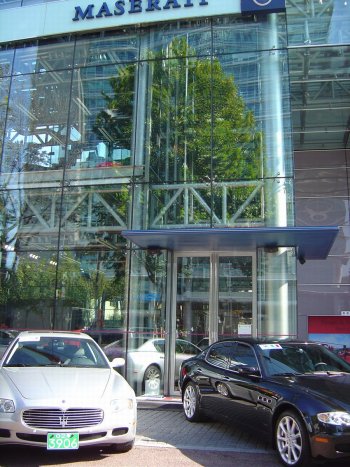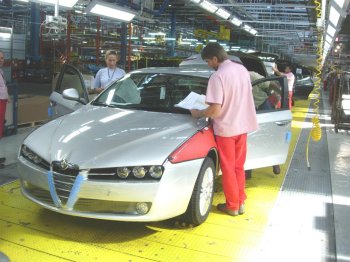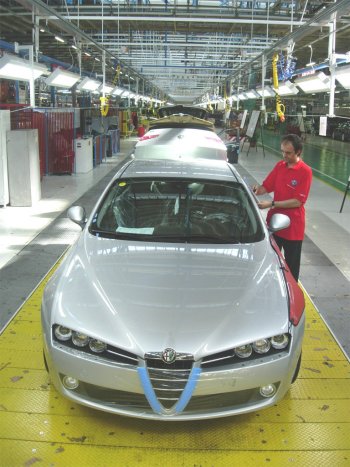|
The Board of
Directors of Fiat S.p.A. met today in Turin under the
Chairmanship of Luca Cordero di Montezemolo to review the
consolidated results of the Group for the third quarter and
first nine months of 2005.
TRADING PROFIT UP SHARPLY TO 232 MILLION, AGAINST A
TRADING
LOSS OF 30 MILLION IN Q3 2004, ON LARGELY STABLE REVENUES,
UP 2% AT 10.6 BILLION
NET INCOME OF 0.8 BILLION
NET INDUSTRIAL DEBT HALVED TO 4.7 BILLION, THANKS TO
CONVERSION OF THE MANDATORY CONVERTIBLE LOAN ( 3.0 BILLION)
AND COMPLETION OF THE ITALENERGIA BIS TRANSACTION ( 1.8
BILLION)
SOLID CASH POSITION OF APPROXIMATELY 6.0 BILLION AFTER
1.2
BILLION BOND REIMBURSEMENT IN THE QUARTER
TRADING LOSS OF THE AUTO SECTOR AT 85 MILLION, SLASHED
BY OVER TWO-THIRDS COMPARED TO Q3 2004
ON TRACK TO ACHIEVE 2005 GROUP TARGETS
The Group
In Q3 2005, all of the businesses of the Fiat Group
continued to improve their performances. Revenues totalled
10.6 billion, reflecting the typical negative seasonality
associated with Q3. The Group achieved a slight (+2%)
increase in revenues over the comparable 2004 quarter
despite the impact of announced new model launches (Fiat
Grande Punto and Alfa 159) on sales of existing products.
Group trading profit was 232 million, compared with a loss
of 30 million in Q3 2004. The 262 million increase in
trading profit was due to a 197 million reduction in
trading losses at Fiat Auto combined with positive
performance of all other industrial Sectors. CNH improved
its trading profit by 21 million, from 112 million to
133 million, Iveco by 28 million, from 74 to 102
million, and Components and Production Systems by 21
million, from 56 to 77 million. Fiat Auto reduced its
trading loss by more than two-thirds, from 282 million in
Q3 2004 to 85 million this quarter; this sharp drop, and
the expected benefit to Q4 results from the contribution of
the new car models launched since September, underscores
that the Sector is on track to achieve its 2005 targets.
Group Q3 2005 results benefited from non-recurring income,
including the gain realized on sale of the investment in
Italenergia BIS ( 878 million) and unusual financial income
of 858 million related to the capital increase of
September 20, 2005 following conversion of the Mandatory
Convertible Loan. The result for the quarter also absorbed
420 million in restructuring charges and other unusual costs
( 284 million) connected with the Groups ongoing
reorganization and rationalization processes.
Net income for the quarter was 0.8 billion. On a pro forma
basis, net of unusual items (chiefly the gain on Italenergia
BIS and the Mandatory Convertible Loan, restructuring
charges and other unusual items) and assuming conversion of
the Mandatory Convertible Loan and closing of the
Italenergia BIS transaction as at July 1, 2005, net income
for the quarter would have been 14 million. Net industrial
debt decreased during the period by 4.5 billion ( 4.7
billion in the first nine months of 2005), chiefly
reflecting reimbursement of the Mandatory Convertible Loan
and of the financial indebtedness related to the Italenergia
BIS transaction. The Groups cash position at September 30
was approximately 6.0 billion, substantially unchanged
from the December 31, 2004 level, after reimbursement of
1.2 billion in bonds in Q3 2005.
Automobiles
Fiat Auto had revenues of 4.3 billion, a slight 0.6%
increase from Q3 2004. Improved product mix and the positive
foreign exchange effect stemming from sales in Brazil and
Poland effectively offset lower volume. Sales were impacted
by intense competitive pressure and a slowdown in sales of
existing models ahead of upcoming new product launches. In
the second half of September, the Italian public was offered
a first opportunity to get acquainted with the new Grande
Punto through a series of open-door events that attracted
over one million people into Fiat dealerships. The new model
is currently going on sale throughout the key European
markets. A total of 35,000 orders have now been received for
the Grande Punto.
Similarly, the new Alfa 159 went on sale in late September.
The Alfa Brera, Panda SUV, and the larger Fiat SUV Sedici
will be presented to the international press in November.
Among the key automobile markets for Fiat Auto, Western
European demand rose by 2.2% in the quarter, with Italy up
4.8%, while Brazil rose by 8%. By contrast, the market
contracted sharply in Poland, where new vehicle
registrations fell by 12.9%. In this context, Fiat Auto
delivered a total of 378,700 vehicles, down 5.9% from the
same period of 2004. Unit sales decreased in all major
European countries (-6.1% in Italy), with the exception of
France, where they were up 5.8%, and Spain, where they were
unchanged. Deliveries also fell in Poland, while Fiat unit
sales outpaced the market in Brazil (10.4% against 8%),
lifting market share from 24.5% to 24.8%. The market share
of Fiat Auto during the quarter was 27.7% in Italy (28.0% in
Q3 2004) and 6.1% in Western Europe (6.9% in Q3 2004). The
performance of Commercial Vehicles remained very strong,
with a 10% share of the European market and over 40% of the
Italian market. Fiats share of the Italian commercial
vehicle market increased from 41.8% to 42.7% in the first
nine months of the year.
In the third quarter of 2005, Fiat Auto had a trading loss
of 85 million, a two-third reduction compared to the 282
million trading loss posted in Q3 2004. This improvement,
achieved in the face of lower volumes, underscores the
effectiveness of the sectors operational strategy, which
focuses on higher margin retention due to a more favorable
product mix and greater use of more profitable sales
channels. The trading performance also benefited from
reduction in product and governance costs, as well as
streamlined R&D.
Maserati had revenues of 114 million in the third quarter,
up sharply (+37%) from the same period in 2004. The
improvement stemmed from higher volumes, thanks to the
success of the Quattroporte and sales of the special MC12
highway models. The trading loss of Maserati was 10
million, as compared to a loss of 13 million in Q3 2004. The improvement was the result of higher volume and a better
sales mix, more than offsetting the negative foreign
exchange effect.
Ferrari posted revenues of 302 million. The significant
improvement from the same period of 2004 (+18%) is
attributable to the success of the new F430. During the
period, sales totaled 1,206 units, a 28% increase from Q3
2004. Ferrari closed the quarter with a trading profit of
42 million, up 12 million from the Q3 2004 level. The
increase reflects higher sales volumes and efficiency gains,
offsetting
negative foreign exchange effects.
Fiat Powertrain Technologies, the new Sector encompassing
all Group engine and transmission activities, posted
revenues of 670 million in the quarter. (Reported data for
2005, relates only to passenger car engines and
transmissions). Production was partially allocated to the
Automobile Sector of the Group, while sales to third parties
totaled 137 million. Trading profit was 9 million.
Agricultural and Construction Equipment
In the third quarter of 2005, CNH revenues totaled 2.5
billion, virtually unchanged from the Q3 2004 level, as
lower agricultural equipment volume was offset by higher
sales of construction equipment. These results reflect
diverging trends in CNHs two reference markets. During the
quarter, the world agricultural equipment market remained
stable overall, as lower demand in America and Western
Europe was offset by higher demand in the rest of the world.
By contrast, the world construction equipment market was up
13%, with increases in lightrange equipment in virtually all
countries. Sales of heavy equipment rose sharply in all
world markets with the exception of Western Europe, where
demand was unchanged.
In the third quarter of 2005, CNH recorded trading profit of
133 million, up from 112 million in Q3 2004. Higher
sales of construction equipment, improved pricing, cost
efficiency gains and greater profitability in financial
services more than offset higher raw material prices and
lower volume in agricultural equipment.
Commercial Vehicles
Iveco had revenues of slightly over 2 billion in the third
quarter of 2005, up by 1.6% compared to Q3 2004; industrial
activities were up 3.2%. The commercial vehicle market in
Western Europe remained positive during the period,
expanding by 3.7%. Higher demand, recorded across all market
segments, was particularly strong in the heavy vehicle
segment, up by 9.2%. Demand for heavy trucks was up in all
countries, notably France and Spain, with the sole exception
of Italy, where the market remained stable.
|

 |
|
Kuzplus Co,
which has been appointed the official Maserati and Ferrari
importer for Korea, has just opened the largest showroom
worldwide dedicated to the two prestige brands |
|
|

 |
|
The new Alfa 159 (above) went on sale in late
September, while the Brera, Fiat Panda SUV and the
larger Fiat Sedici SUV will be presented
to the international press
in November |
|
|
In the third quarter, Iveco delivered a total of 37,600
vehicles, up 4.5% over Q3 2004. Iveco posted a trading
profit of 102 million in the third quarter. The 28
million improvement compared to Q3 2004 primarily reflects
higher volume and pricing, offsetting the increase in raw
materials costs and a less favorable geographical mix.
During the period, the powertrain activity produced 96,800
engines (+3%), generating revenues of 533 million, 56% of
which represents deliveries to the Commercial Vehicles
Sector. Trading profit of the powertrain activity was 15
million, against 16 million reported in Q3 2004.
Components and Production Systems
Magneti Marelli had revenues of 923 million. The 5.7%
increase compared to Q3 2004 partly reflected inclusion of
Mako, a company consolidated since January 1, 2005. On a
comparable consolidation and foreign exchange basis,
revenues increased by 2%. During the period, the strong
performance of Magneti Marelli operations in Brazil and
Poland enabled it to offset lower sales volume in Italy.
On a comparable scope of consolidation, the trading profit
of
Magneti Marelli was in line with that of Q3 2004 ( 36
million), as higher raw material prices were offset by
wideranging efficiency gains. During the quarter, the
powertrain activities of the Sector had revenues of 182
million, up 8% over Q3 2004, and a trading profit of 8
million, down from 13 million in the comparable 2004
quarter. Teksid had revenues of 252 million, up 17% from
Q3 2004, reflecting higher pricing to absorb the increase
raw material costs, as well as positive foreign exchange
impact and higher volumes. Both the Cast Iron Business Unit,
with a 2.9% increase in volume, and the Magnesium Business
Unit, up 2.3%, contributed to the positive result. The
increase in contract work at Teksid during the first nine
months of the year was satisfactory. Teksid recorded a
trading profit of 14 million.
Comau posted revenues of 422 million. Compared with the
third quarter of 2004, the 4.1% drop stems from the transfer
to Iveco, Magneti Marelli, and CNH of Comaus European
service activities. Net of changes in the scope of
consolidation, Comau revenues rose by 10% during the
quarter, due to strong performance of the Car Bodywork and
Maintenance areas. Comaus trading profit rose an impressive
15 million to 25 million in the third quarter of 2005,
as the company began to benefit from the restructuring and
cost-reduction plans implemented by its North American
operations, in particular.
Other Businesses
Business Solutions had revenues of 206 million in the
third quarter, down 16.3% from Q3 2004. The decrease stemmed
partly from the sale of the temporary employment agency
Worknet. On a comparable basis, the decrease in revenues was
approximately 8%, reflecting lower activity in the
administration area, following redefinition of the services
provided to Group companies. The trading profit of Business
Solutions was 13 million during the period, up from 9
million in Q3 2004. The increase primarily reflects
efficiency gains.
Itedi had revenues of 83 million. The 2.5% increase from
Q3 2004 resulted mainly from higher advertising revenues
achieved by Publikompass. During the third quarter of 2005,
a traditionally weak period in the seasonal advertising
market, Itedi had a trading loss of 3 million, against a
loss of 2 million in Q3 2004. The decline reflects costs
incurred for promotional activities, which are expected to
have a positive impact in the final months of the year. The
result of residual activities, together with eliminations
and consolidation adjustments, shows a decrease of 32
million in the third quarter, mainly due to lower volumes
for the High Speed Railway (TAV) project contract, the
different mix of services provided by Group Sectors, and
higher consolidation adjustments.
Group results during the first nine months
In the first nine months of 2005, Fiat Group revenues
totaled 33.4 billion, substantially in line with revenues
achieved in the corresponding period of 2004. Revenues were
impacted by the lower automobile demand in Europe and
notably in Italy in the first half of the year, as well as
slower sales of existing products ahead of now model
launches. The Groups trading profit more than tripled,
rising from 175 million to 639 million, thanks mainly to
the good results achieved by CNH and Iveco and the strong
improvement posted by Fiat Auto, which more than halved its
trading loss.
Fiat Group Financial Highlights
Net income before minority interests was 1.3 billion,
against a loss of 1.0 billion in the first nine months of
2004. The improvement reflects growth in trading profit as
well as the positive contribution from the General Motors
settlement ( 857 million net of taxes), the gain on the
Italenergia Bis transaction ( 878 million), and the one-off
financial income connected with the conversion of the
Mandatory Convertible Loan ( 858 million), net of
restructuring charges amounting to 502 million and other
unusual costs for 318 million.
Net industrial debt was halved from 9.4 billion to 4.7
billion due to conversion of the Mandatory Convertible Loan
( 3.0 billion) and the financial indebtedness related to
the Italenergia Bis transaction ( 1.8 billion). The cash
position of the Group at September 30, 2005 was
approximately 6.0 billion, largely unchanged from the
December 31, 2004 level, after reimbursement of bonds for
1.6 billion.
Full-year outlook
In the first nine months of the year, the Fiat Group and all
of its main Sectors sharply improved their operating
performance and financial results. Consequently, Fiat is on
track towards achieving its stated targets. Since the
beginning of the year, the Group also succeeded in finding
optimal solutions to pending financial issues. With net
stockholders equity of approximately 9 billion and net
industrial debt of less than 5 billion, Fiat can now focus
on its manufacturing infrastructure, distribution networks,
and product offerings, with the support of its main
shareholder, which in recent weeks chose to maintain and
strengthen its commitment to the Group.
In particular, Fiat Auto drastically reduced its losses,
while introducing a host of new models that have been very
well received by customers. As part of its aggressive
program to renew its product range, Fiat is planning on
launching 20 new models and restyling an additional 23.
Between 2005 and 2008, Fiat will invest 10 billion to
support this plan, including 4 billion in R&D. So as to
further strengthen the Automobile Sector, Fiat continued to
seek strategic alliances with major partners. Fiat recently
signed two memoranda of understanding, with Ford and with
the Indian group Tata Motors Ltd, to study collaboration
opportunities. The talks with Ford are aimed at assessing
the feasibility of jointly developing two new vehicles in
the small car segment (the future Fiat 500 and the successor
to the Ford Ka), while the agreement with Tata would focus
on broader cooperation in the automotive arena, including
development, manufacturing, components, purchasing and
distribution. In October, Fiat signed a letter of intent
with Suzuki Motor Corporation (SMC) to study the feasibility
of licensed manufacture of the new Euro 5-compliant 2.0 JTD
Multijet diesel engine, developed by Fiat Powertrain
Technologies. Production of the new engine will start in
Italy in 2008, and pursuant to the letter of intent,
manufacturing in Asia could commence in 2010, with a
targeted volume of approximately 100,000 units.
These agreements represent further steps in the alliance
strategy implemented with PSA Peugeot Citroλn and Tofas for
the joint development and production of a light commercial
vehicle, and with Suzuki to develop and manufacture an SUV
that will debut in conjunction with the Turin Winter
Olympics in Q1 2006.
Based on the promising results achieved to date, Fiat Auto
can confirm its 2005 target of reducing its trading loss to
approximately 1.5% of revenues. The other Sectors are
proceeding with their own profit improvement plans, and
charges have been booked in the third quarter to reflect the
acceleration of their restructuring activities. The Fiat
Group can therefore be cautiously optimistic about its
future and confirms its 2005 targets.
|
|
|
|
![]()
![]()